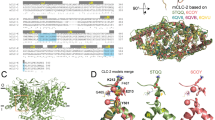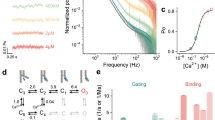Abstract
THE Torpedo chloride channel CIC-0 (ref. 1) is the prototype of a large family of chloride channels that have roles in transepithelial transport2 and in regulating electrical excitability3–6 and cell volume7. CIC-0 opens in bursts with two identical conductance levels of ˜8pS (refs 8–10). Hyperpolarization slowly increases the probability of bursts ('slow gating'), and depolarization increases channel opening within bursts ('fast gating'). Replacing serine 123 by threonine changes rectification, ion selectivity and gating, but retains the typical bursting behaviour with two identical independent albeit reduced, conductance states (˜1.5pS). Coexpression with wild-type CIC-0, either as covalently linked concatamers or as independent proteins, leads to bursting channels with two different pores. Our experiments strongly suggest that conductance, ion selectivity and 'fast' gating are determined only by the single subunit forming a single pore, independent from the attached pore; in contrast, 'slow' gating is a function of both subunits. Thus CIC-0 is a homodimer with two largely independent pores.
This is a preview of subscription content, access via your institution
Access options
Subscribe to this journal
Receive 51 print issues and online access
$199.00 per year
only $3.90 per issue
Buy this article
- Purchase on Springer Link
- Instant access to full article PDF
Prices may be subject to local taxes which are calculated during checkout
Similar content being viewed by others
References
Jentsch, T. J., Steinmeyer, K. & Schwarz, G. Nature 348, 510–514 (1990).
Lloyd, S. E. et al. Nature 379, 445–449 (1996).
Steinmeyer, K. et al. Nature 354, 304–308 (1991).
Koch, M. C. et al. Science 257, 797–800 (1992).
Steinmeyer, K., Lorenz, C., Pusch, M., Koch, M. C. & Jentsch, T. J. EMBO J. 13, 737–743 (1994).
Pusch, M., Steinmeyer, K., Koch, M. C. & Jentsch, T. J. Neuron 15, 1455–1463 (1995).
Gründer, S., Thiemann, A., Pusch, M. & Jentsch, T. J. Nature 360, 759–762 (1992).
Miller, C. Phil. Trans. R. Soc. Lond. B 299, 401–411 (1982).
Miller, C. & White, M. M. Proc. Natl Acad. Sci. USA 81, 2772–2775 (1984).
Bauer, C. K., Steinmeyer, K., Schwarz, J. R. & Jentsch, T. J. Proc. Natl. Acad. Sci. USA 88, 11052–11056 (1991).
Brandt, S. & Jentsch, T. J. FEBS Lett. 377, 15–20 (1995).
Greene, J. R., Brown, N. H., DiDomenico, B. J., Kaplan, J. & Eide, D. J. Mol. Gen. Genet. 241, 542–553 (1993).
Fujita, N., Mori, H., Yura, T. & Ishihama, A. Nucleic Acids Res. 22, 1637–1639 (1994).
Pusch, M., Ludewig, U., Rehfeldt, A. & Jentsch, T. J. Nature 373, 527–531 (1995).
Middleton, R. E., Pheasant, D. J. & Miller, C. Biochemistry 33, 13189–13198 (1994).
Jan, L. Y. & Jan, Y. N. Nature 371, 119–122 (1994).
Author information
Authors and Affiliations
Rights and permissions
About this article
Cite this article
Ludewig, U., Pusch, M. & Jentsch, T. Two physically distinct pores in the dimeric CIC-0 chloride channel. Nature 383, 340–343 (1996). https://doi.org/10.1038/383340a0
Received:
Accepted:
Issue Date:
DOI: https://doi.org/10.1038/383340a0
This article is cited by
-
Cryo-EM structures of the TTYH family reveal a novel architecture for lipid interactions
Nature Communications (2021)
-
Structure of a CLC chloride ion channel by cryo-electron microscopy
Nature (2017)
-
Helix O modulates voltage dependency of CLC-1
Pflügers Archiv - European Journal of Physiology (2017)
-
Identification and characterization of the zebrafish ClC-2 chloride channel orthologs
Pflügers Archiv - European Journal of Physiology (2015)
-
Molecular determinants of common gating of a ClC chloride channel
Nature Communications (2013)
Comments
By submitting a comment you agree to abide by our Terms and Community Guidelines. If you find something abusive or that does not comply with our terms or guidelines please flag it as inappropriate.



